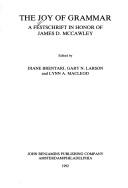| Listing 1 - 2 of 2 |
Sort by
|
Book
ISBN: 0521883709 9780521883702 9780511712203 9780521710039 9780511713019 0511713010 9780511715105 0511715102 9780511723155 0511723156 0511712200 0521710030 1316088316 0511850069 1282558447 9786612558443 0511713843 0511716346 661255844X Year: 2010 Publisher: Cambridge New York Cambridge University Press
Abstract | Keywords | Export | Availability | Bookmark
 Loading...
Loading...Choose an application
- Reference Manager
- EndNote
- RefWorks (Direct export to RefWorks)
What are the unique characteristics of sign languages that make them so fascinating? What have recent researchers discovered about them, and what do these findings tell us about human language more generally? This thematic and geographic overview examines more than forty sign languages from around the world. It begins by investigating how sign languages have survived and been transmitted for generations, and then goes on to analyse the common characteristics shared by most sign languages: for example, how the use of the visual system affects grammatical structures. The final section describes the phenomena of language variation and change. Drawing on a wide range of examples, the book explores sign languages both old and young, from British, Italian, Asian and American to Israeli, Al-Sayyid Bedouin, African and Nicaraguan. Written in a clear, readable style, it is the essential reference for students and scholars working in sign language studies and deaf studies.
Sign language. --- Deaf --- Gesture language --- Language and languages --- Gesture --- Signs and symbols --- Sign language --- Arts and Humanities --- Language & Linguistics

ISBN: 9027220956 1556194544 9786613592620 9027274061 1280497394 9789027274069 1556194552 9027220964 9789027220950 9781556194542 9781556194559 9789027220967 Year: 1992 Publisher: Amsterdam Philadelphia J. Benjamins Pub. Co.
Abstract | Keywords | Export | Availability | Bookmark
 Loading...
Loading...Choose an application
- Reference Manager
- EndNote
- RefWorks (Direct export to RefWorks)
Two threads run through this collection of 22 papers by students and colleagues of James D. McCawley. The first is a commitment to deep reflection on the direction of linguistic study, sometimes resulting in challenges to the writings of major figures or new appreciations, sometimes questioning our assumptions about the organization of linguistic information in the mind. The second thread is a shared sense of the requirements for the rigor of a good linguistic argument, that its presentation be thoroughgoing, straightforward and clearly made. There is a strong emphasis on testing the "party
Grammar, Comparative and general. --- Linguistics --- Philology
| Listing 1 - 2 of 2 |
Sort by
|

 Search
Search Feedback
Feedback About UniCat
About UniCat  Help
Help News
News